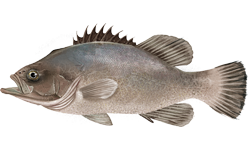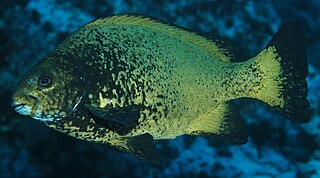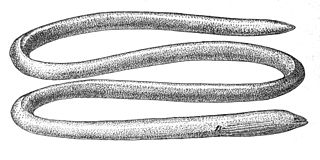
The wreckfish are a small group of ray-finned fish in the genus Polyprion, belonging to the monotypic family Polyprionidae in the order Acropomatiformes.

The sea chubs, also known as rudderfish and pilot fish and in Hawaiian as enenue or nenue, are a family, Kyphosidae, of fishes in the order Perciformes native to the Atlantic, Indian and Pacific Oceans usually close to shore in marine waters.

Stichaeidae, the pricklebacks or shannies, are a family of marine ray-finned fishes in the suborder Zoarcoidei of the order Scorpaeniformes. Most species are found in the North Pacific Ocean with a few in the North Atlantic Ocean.
Cyema is a monospecific genus of marine ray-finned fish belonging to the monotypic family Cyematidae. The only species in the genus is Cyema atrum, the arrow eel, bobtail eel, bobtail snipe eel or deepwater eel. This species has circumglobal distribution.

The Moringuidae are a small family of eels commonly known as spaghetti eels or worm eels, although the latter name is also shared with other families of eels.
Remora is a genus of remoras native to temperate to tropical marine waters worldwide.

Dermatolepis is a genus of marine ray-finned fish, groupers from the subfamily Epinephelinae, part of the family Serranidae, which also includes the anthias and sea basses. They are found in the western Atlantic, Pacific and Indian Oceans.

Ophisternon is a genus of swamp eels found in fresh and brackish waters in South and Southeast Asia, New Guinea, Australia, Middle America and West Africa. Two species are blind cave-dwellers.

Plectropomus, commonly known as the coral groupers, is a genus of marine ray-finned fish, groupers from the subfamily Epinephelinae, part of the family Serranidae, which also includes the anthias and sea basses. They are found in the Indo-Pacific region.

Heteromormyrus is a genus of freshwater ray-finned fishes belonging to the family Mormyridae, the elephantfishes. These fishes are found in southern and central Africa in Angola, Namibia, the Democratic Republic of the Congo and, maybe, Zimbabwe.
Polyacanthonotus is a genus of spiny eels, with these currently recognized species:
Chilorhinus is a small genus of marine ray-finned fishes belonging to the family Chlopsidae, the false morays. These eels occur in tropical waters

Moringua is a genus of eels of marine ray-finned fishes belonging to the family Moringuidae, the spaghetti eels. These eels occur in shallow tropical and subtropical waters.
Nemichthys is a genus of eels in the snipe-eel family Nemichthyidae. It currently contains the following species:

Dysomma is a genus of marine ray-finned fishes belonging to the family Synaphobranchidae, the cutthroat eels. These eels are found in the Atlantic, Indian and Pacific Oceans.

Bangana is a genus of fish in the family Cyprinidae, the carps and minnows. It is distributed across much of southern and eastern Asia. Species live mainly in the flowing waters of tropical and subtropical rivers.

Brotula is a genus of cusk-eels. It is the only genus in the subfamily Brotulinae.

Synbranchus is a genus of swamp eels native to Central and South America.

Pseudocaranx is a genus of ray-finned fishes from the family Carangidae, the jacks, trevallies, scads, and pompanos. They occur in the western Atlantic Ocean and the Indo-Pacific.

Selene is a genus of carangids, commonly known as lookdowns and moonfishes, native to the Atlantic Ocean and the eastern Pacific Ocean.














